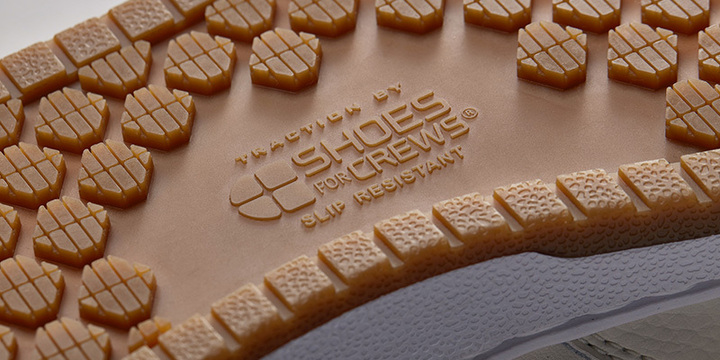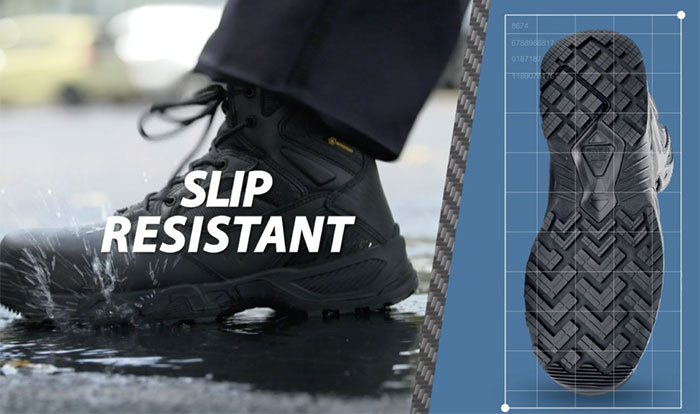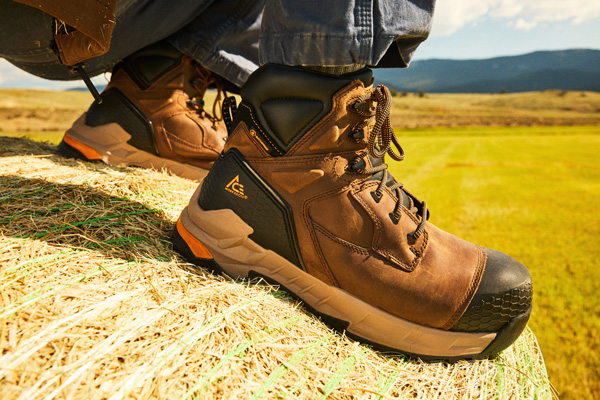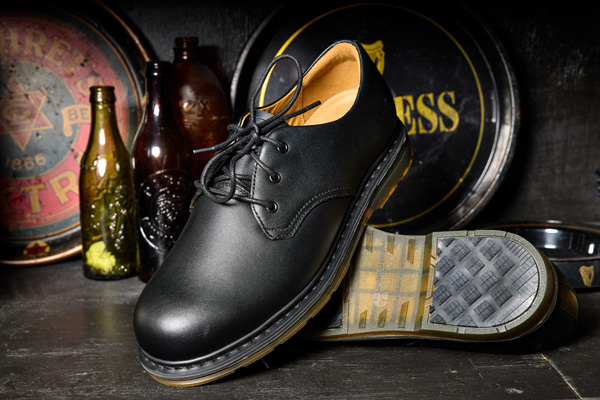How to Make Work Shoes Last Longer: Tips That Actually Work

When you spend all day on your feet, your shoes aren’t just part of your uniform—they’re your foundation. They hit the concrete before sunrise, stand through 10-hour shifts, and carry you across slick floors, gravel yards, or hospital corridors. Every step tells the story of your workday.
But when those shoes start to break down too soon—when the tread thins, the leather cracks, or the soles flatten—you feel it in your feet, your back, and your wallet. Comfort, stability, and protection all take a hit.
Even the toughest work shoes can wear out fast if you don’t care for them correctly. Dirt builds up, moisture sneaks in, and repeated strain grinds down the structure a little more each day.
This guide lays out ways to make your work shoes last longer, from cleaning and conditioning to rotation routines and knowing when to replace. Follow these work shoe maintenance tips to protect your investment and keep every step safer and stronger.

Maintenance Tips to Extend Work Shoe Life
Clean Your Shoes Regularly
You know that gritty sound when dust grinds under your soles? That’s wear happening in real time. Dirt, grime, and moisture are silent killers for shoes—tiny abrasives that slowly sand down the materials, while salt and chemicals weaken seams and adhesives.
By cleaning your work shoes daily, you’ll slow down wear, preserve traction, and prolong the life.
Recommended cleaning methods by material:
- GLADIATOR™ or Easy Clean outsoles from Shoes For Crews®: Built with wide, shallow channels that let dirt and debris fall out naturally, these outsoles stay cleaner longer and resist buildup, even after long shifts on messy surfaces.
- Lugged or patterned soles: Many of our slip-resistant shoes use tight, square-shaped lugs that dig into wet, oily floors for extra traction. Use a soft brush or even a toothpick to clear stuck gravel and grime.
- Rubber or synthetic outsoles: Stick with mild soap and water, and don’t use harsh chemicals. Scrub gently, rinse clean, and air dry.
- Uppers: Wipe down with a damp cloth, brush lightly, and dry away from direct heat to avoid cracking or warping.
Keep this up, and your shoes won’t just look better, but they’ll feel better underfoot, day after day.
How to Care for Leather Work Shoes
Leather shoes have that satisfying weight and solid feel when you lace them up. They mold to your feet, soften with use, and can last a while if you give them the right care.
Here's how to protect your genuine leather work shoes and make the most of their durability:
- Condition regularly: Use a quality leather conditioner or cream to keep leather flexible and prevent cracking.
- Polish sparingly: Add water resistance and shine, but don’t overdo it—you want leather to breathe.
- Spot clean smartly: Tackle oil or grease with a proper leather cleaner. Always blot and never scrub.
- Handle water with care: If your shoes get soaked, stuff them with paper, let them air dry naturally, then recondition.
Leather is tough by nature. Keep it clean, conditioned, and protected, and it’ll carry you through season after season of hard work.
Rotate Work Shoes Daily
Let Shoes Recover Between Shifts
That end-of-day ache you feel in your feet? Some of it comes from tired shoes. When you wear the same pair every single day, cushioning stays compressed, foam breaks down faster, and moisture gets trapped inside, creating a perfect storm for odor and wear.
Rotating your shoes gives them a breather. It lets them dry out, rebound, and recover their shape. It’s how to prevent work shoes from wearing out too soon.
Tips for effective shoe rotation:
- Keep at least two pairs handy and alternate daily.
- Let each pair rest 24 hours before the next wear.
- In extra‑tough environments—wet floors, hot kitchens, dusty sites—consider rotating between three pairs.
Choose Durable Work Shoes for Rotation
Rotation only works if each pair is made to handle the job. Choose shoes with:
- Full‑grain leather uppers
- Shoes For Crews abrasion-resistant 4HD rubber outsoles
- Slip-resistant treads
- Strong stitching and reinforced midsoles
Protecting Work Shoes from Daily Damage
Use Insoles to Reduce Wear and Tear
Your insoles quietly carry the load with every step. But they also take a beating. Swapping them out with high-quality insoles for work shoes can make a big difference:
- They absorb shock, reducing strain on midsoles.
- They prevent liner breakdown by minimizing friction.
- They improve support, reducing foot pain and uneven wear.
Using the right insoles helps you reduce wear from the inside out.
Invest in Sole Protectors and Storage Solutions
When your shoes are off, they still need care. Here’s how to protect them between shifts:
- Sole protectors: Slip-on shoe covers or overlays keep tread from wearing down on abrasive surfaces like concrete.
- Shoe bags and boxes: Keep them dust-free and safe from accidental scuffs.
- Proper shoe storage: Store shoes in a cool, dry place. Avoid damp lockers, direct sunlight, or heaters that can warp soles.
These steps help protect work shoes from damage when they’re off your feet.
Common Mistakes That Shorten Shoe Life
Even with good gear, bad habits cost you. Here are common pitfalls to avoid:
- Wearing wet shoes: Always dry them fully before the next use. Wet shoes break down quickly.
- Skipping the clean-up: A quick 2-minute brush or wipe keeps buildup from eating through material.
- Ignoring fit: Shoes that are too loose or too tight wear unevenly and put strain on seams and structure.
- Overloading one pair: Wearing the same shoes for everything—work, errands, chores—shortens their work life.
Being consistent with small habits adds months of wear.
When to Replace Your Work Shoes

Our golden rule: Replace every 6 months—sooner if your job is demanding or conditions are rough.
Watch for these signs:
- Tread is smooth or worn through
- Cracks or deep creases in the midsole
- Uppers are splitting or detached
- You feel new aches or instability
- Slipping or loss of traction
- Safety components like steel toe or slip rating no longer feel secure
If structure or safety is compromised, replace them immediately.
Takeaways
Let’s bring it home with the four pillars of keeping your work shoes in fighting shape:
- Clean and maintain – Remove grime, condition leather, and clean outsoles regularly
- Rotate your shoes – Give them time to rest and recover
- Protect between uses – Use insoles, covers, and store them right
- Replace when necessary – Don’t wait for a breakdown to act
Your work shoes are more than gear; they’re part of your daily protection. Treat them right, and they’ll take care of you with every step you take.
FAQs
Q1: How often should I clean my work shoes?
Ideally after each heavy use or at least once a week. In dirty or wet jobs, daily rinsing is wise.
Q2: Can I wash my work shoes in the washing machine?
Generally, no. Most work shoes—especially those made with leather, steel toes, or slip-resistant outsoles—should not go in the washing machine. The agitation, water temperature, and detergents can weaken glue, warp soles, and damage protective features. Always clean work shoes by hand using the proper method for the material.
Q3: What are the best insoles for reducing wear in work shoes?
Look for shock-absorbing gel insoles, high-density foam, or dual‑density support. Replace them when they compress or lose their shape.
Q4: When should I replace my work shoes? Can I repair them instead of buying new ones?
We recommend replacing your work shoes every 6 months. Depending on your job and how much you wear them, replacement might be necessary sooner. Shoes For Crews are designed for specific work specifications, so repairs will likely affect their usage. Please check the treads and structure regularly. If everything is in great shape, repairs may be worth it.
Q5: Are expensive work shoes worth it for durability?
Often, yes. Premium materials and construction (like full-grain leather and stitched soles) tend to last longer, saving you money long-term
Employees and Your Bottom line.
Don't Forget To Share This Post!

The Key to Slip-Resistant Safety Shoes
Not all slip-resistant shoes for workers are equal. Find out how genuine slip-resistant footwear carries a high Coefficient of Friction (COF) score.

Workplace Safety 101: Preventing Slips, Trips and Falls
Preventing slips, trips, and falls is Workplace Safety 101 and of the utmost importance. SFC Safety explains how everyone can ensure a safe work environment.

How to Create an Accident Incident Rate Benchmark
How does your company stack up to the national injury incident rate averages? Learn how to calculate accident ratios to benchmark new safety guidelines.


